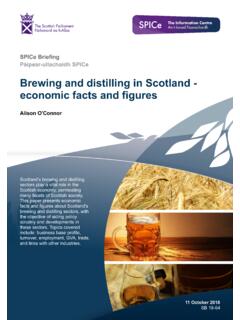Transcription of Risk management in agriculture
1 4 July 2018SB 18-46 SPICe BriefingP ipear-ullachaidh SPICeRisk management in agricultureGareth ThomasThis briefing examines riskmanagement policies foragriculture. Currently, events whichnegatively impact agriculturalproductivity, such as adverseweather, price fluctuations anddisease events, are oftenaddressed in the UK through adhoc payments from , in the United States,Canada, Australia and NewZealand, instruments addressingrisk management are built intoagricultural policy. With agriculturalpolicy about to change in the UK,consideration of policy instrumentsused by these countries to managerisk may be Summary_____4 Background_____5 What is risk in agriculture ?_____7 Policy context of risk management_____8 European Commission_____8UK Government_____8 Health and Harmony paper, Defra_____8 Scottish Government_____9 Levels of risk and the need for support_____10 Managing market variations_____10 Managing catastrophic variations_____11 Aid package from the European Commission for dairy crisis_____11Ad hoc payments from UK Government in 2001_____12Ad hoc payments from Scottish Government in 2018_____12 The effectiveness of ad hoc payments_____13 Risk management policies in the EU, the United States, Canada, Australia andNew Zealand_____14 European Union (Common Agricultural Policy)_____14 Pillar 1 (Direct payments)_____14 Pillar 2 (Scottish Rural Development Programme)
2 _____15 United States Department of Agriculture_____16 Commodity programmes_____17 Crop Insurance programmes_____17 Canadian Agricultural Partnership_____18 Australia_____20 Examples of disaster assistance measures_____20 Examples of tax concessions_____21 New Zealand_____21On farm adverse events recovery planMelyukhina, 2011_____22 Small-scale risk_____23 Medium-scale risk_____23 Large-scale risk_____23 Pros and cons of risk management strategies_____251) Direct payments_____252) Government-subsidised insurance_____25 Risk management in agriculture , SB 18-4623) Market-oriented strategies_____26 Bibliography_____28 Risk management in agriculture , SB 18-463 Executive SummaryAgriculture is particularly prone to business risks. This year, the Scottish Governmentunveiled a fund of 250,000 to farmers and crofters to compensate for lost stock due toadverse weather from the Beast from the East . Scottish farmers have received other adhoc payments to help them deal with unexpected events.
3 For example, for fluctuations indairy prices in 2016 and during the foot and mouth disease crisis in the current EU Common Agricultural Policy, farmers receive direct payments, whichare guaranteed annual payments to farmers. They act as a form of risk management , byshielding farmers from strong fluctuations in markets. However, some countries build riskmanagement explicitly into their agriculture policy. As agricultural policy changes in the UKin the coming years, examination of risk management policies in these countries may , George Eustice, Minister of State at the Department for Environment, Food andRural Affairs has said We are looking at a range of policy options around riskmanagement and resilience. We are looking at the approach taken in countries like and Canada, and even Australia, where they have approaches that help farmersmanage risks, whether they be weather risks or large downturns in margins, for instance.
4 This briefing examines the risk management policies in the United States, Canada,Australia and New the , farmers adopt either commodity programmes which support incomes whenprices or revenue fall below reference levels, or government-subsidised crop insuranceschemes which can cover both yield and revenue Canadian Government has developed various business risk managementprogrammes to address different layers of public response to risk in agriculture ;AgriInsurance, AgriStability, AgriRecovery, AgriInvest, AgriRisk Australian Government provides a series of disaster assistance measures andtaxation measures to support farmers in the management of business New Zealand Government offers a layered approach to risk management , through theadverse events recovery plan. Government assistance measures can be administered insmall, medium and large-scale adverse and consof different approaches are discussed. For example, direct paymentsprovide a guaranteed source of income to EU farmers, although these payments do notprovide a means to tackle market volatility.
5 Furthermore, it has recently been argued thatalthough government-subsidised insurance has a large uptake in the , it could makefarmers less resilient to climate change, and could lead to more risk taking by strategies such as forward contracts and futures markets can reduce thecost of subsidies, but they can be difficult to administer for some agricultural management in agriculture , SB 18-464 BackgroundSeventy three percent of Scotland s land mass is under agricultural production, million 1provides statistics on the economic importance ofagriculture to the Scottish economy. The total income from farming in Scotland in 2017was 917 million2. For such an economically important sector, appropriate agriculturalpolicies must be in place,for the provision of public goods, and to ensure food to the variability in the economic and biophysical environment in which it operates,agricultural activity is particularly prone to a range of business risks.
6 Markets have beenaffected byeconomic disturbances, disease outbreaks and adverse weather events4. Forexample, in 2007/2008, a food commodity price spike occurred,creating a global crisisand leading to political and economic an efficient system to address these business risks in agriculture can preserve thestandard of living of those who depend on farming, strengthen the viability of farmbusinesses, andprovide an environment which supports investment in the farming management in agriculture , SB 18-465 Figure 1. Summary of Statistics of Scottish agriculture from National FarmersUnion, ScotlandSource- National Farmers Union Scotland (NFUS), a new agricultural policy management in agriculture , SB 18-466 What is risk in agriculture ?Gomes (1999)6proposes a simple definition of risk - A loss due to a damaging event .This can be easily measured, for example by quantifying the loss of agricultural income orproductivity, as a result of anything which can compromise the productivity of the of risk in agricultureA report by the Scottish Government identified the most common sources of risks toScottish agriculture , based on categoriespre-determined by the Organisation forEconomic Co-operation and Development (OECD) in 20087.
7 Market/price riskinvolves uncertainty about future changes in prices of inputs andoutputs due to shocks, trade policy and new markets. Unpredictable socio-economicfactors can lead to sudden changes in supply and demand, impacting market price(See 'Aid package from European Commission for dairy crisis'). Production/yield riskincludes weather related factors, crop and livestock diseases,and technological changes which can impact crop and livestock performances (See'Ad hoc payments from Scottish Government in 2018'). Institutional or regulatory riskrefers to unpredictable changes in the provision ofservices from institutions which support farming. Financial riskincludes uncertainty about financial flows within a business due tovariability in interest rates, access to credit and value of financial assets can lead tofinancial risk. Personnel riskrefers to risks to the farm business caused by illness or death and thepersonal situation of the farm management in agriculture , SB 18-467 Policy context of risk managementRisks in agriculture are managed in some countries by integrating risk management toolsinto agricultural policies.
8 Such policies are getting the attention of agricultural policymakers across the European Commission, the UK Government and the CommissionIn aFuture of food and farming press release from the EU commission8, which discussesthe future of the Common Agricultural Policy (CAP), a key priority area is "Creating an EU-level platform on risk management on how best to help farmers cope with the uncertaintyof climate, market volatility and other risks".UK GovernmentWritten evidence from the Department for Environment, Food and Rural Affairs (Defra)9totheEuropean Union Lords Select Committee10states:George Eustice MP, Minister of State for Defra, made a statement in theHouse ofCommons meeting on Brexit: agriculture and Fisheries11:He further indicatedinterest in risk management approaches in other countries12:Health and Harmony paper, DefraThe Health and Harmony13 paper from Defra, highlighting the future for food, farmingand the environment, includes a section on risk management and resilience.
9 Marketvolatility is discussed, mentioning the need for farmers' access to tools to managementmarket volatility year-to-year: Farmers wishing to mitigate price risk have at their disposal a number of market-based solutions, including forward contracts, futures markets, swaps and options, andsimilar over-the-counter products. According to Defra, farmers have used such toolsfor a long time in the United States, where agricultural commodity prices fluctuatewidely. We are looking at a range of policy options around risk management and are looking at the approach taken in countries like the and Canada, and evenAustralia, where they have approaches that help farmers manage risks, whether theybe weather risks or large downturns in margins, for instance. I want us to explore the potential for government-backed insurance schemes likethey have in Canada and futures markets like they have in the to help mitigaterisk.
10 Risk management in agriculture , SB 18-468As well as short-term market volatility, support for farmers experiencing significant crisesare also mentioned in the white paper:Removal of direct payments13to farmers is also proposed:The agriculture and Horticulture Development Board (AHDB)14state that insurancepremiums, covering losses caused by adverse climatic events, animal or plant diseases,pest infestation, or an environmental incident, would need to be subsidised to becommercially viable in the UK, as is the case in the :Taken together, the white paper indicates that the UK Government could be looking toadopt a more risk management oriented agricultural GovernmentOne outcome from the National Discussion on the Future of Scottish Agriculture2015-2016 (set out infuture of farming paper15) was: We are consulting on the barriers to wider development of insurance, futurescontracts and other risk management tools, and how government can encourage theiradoption.




